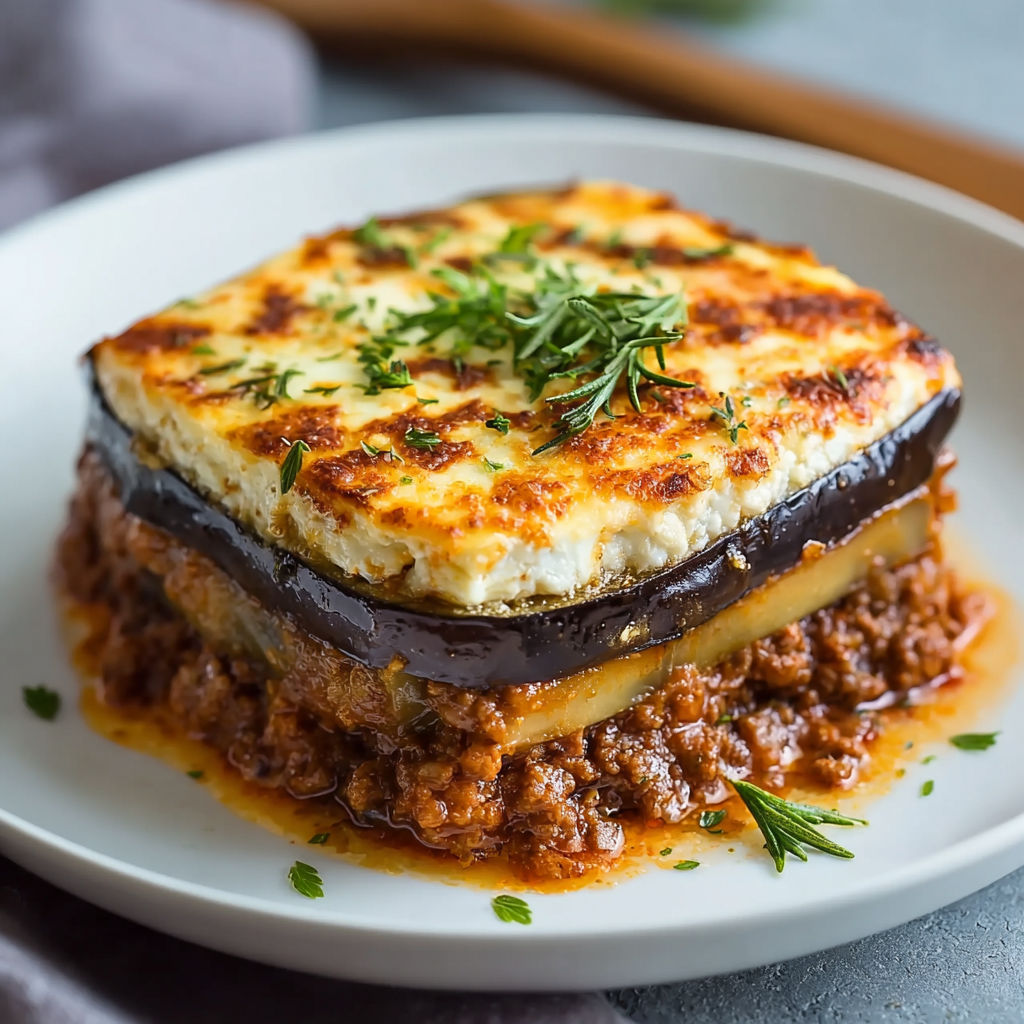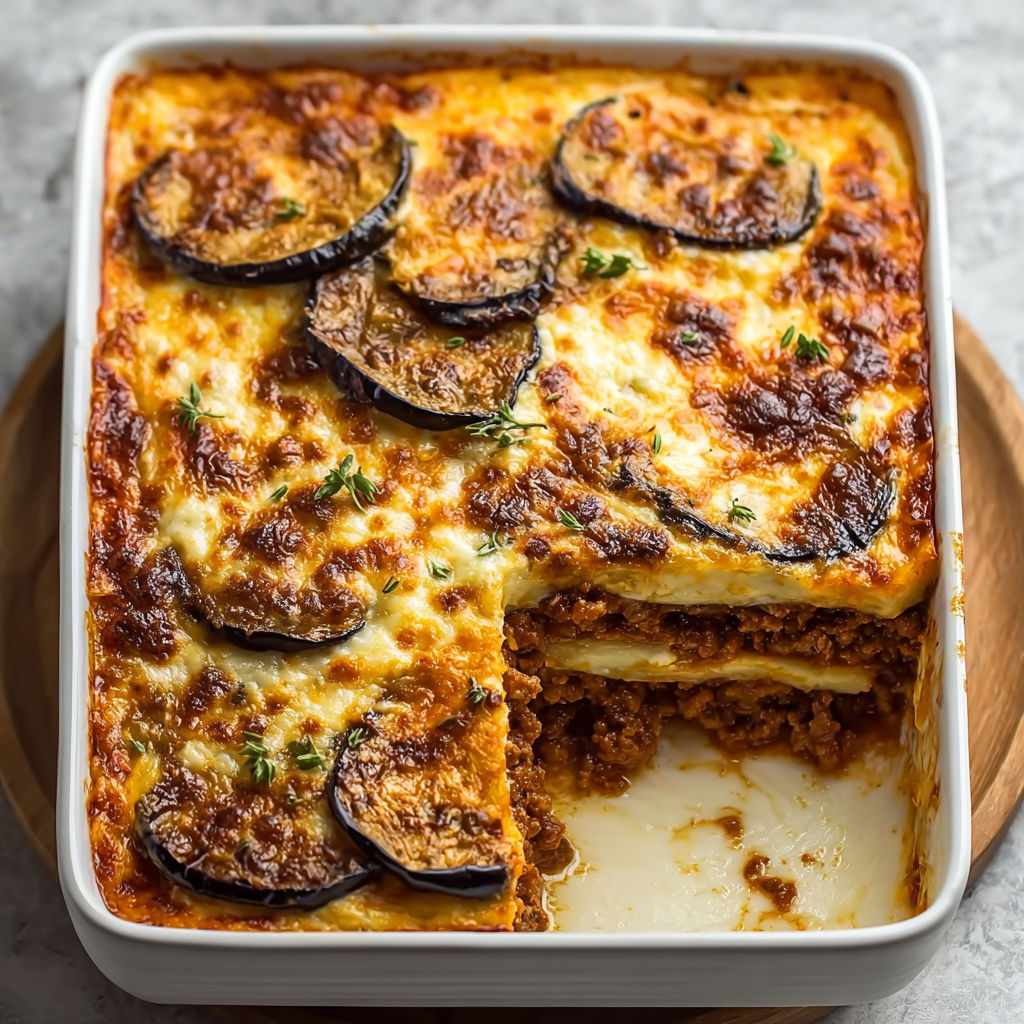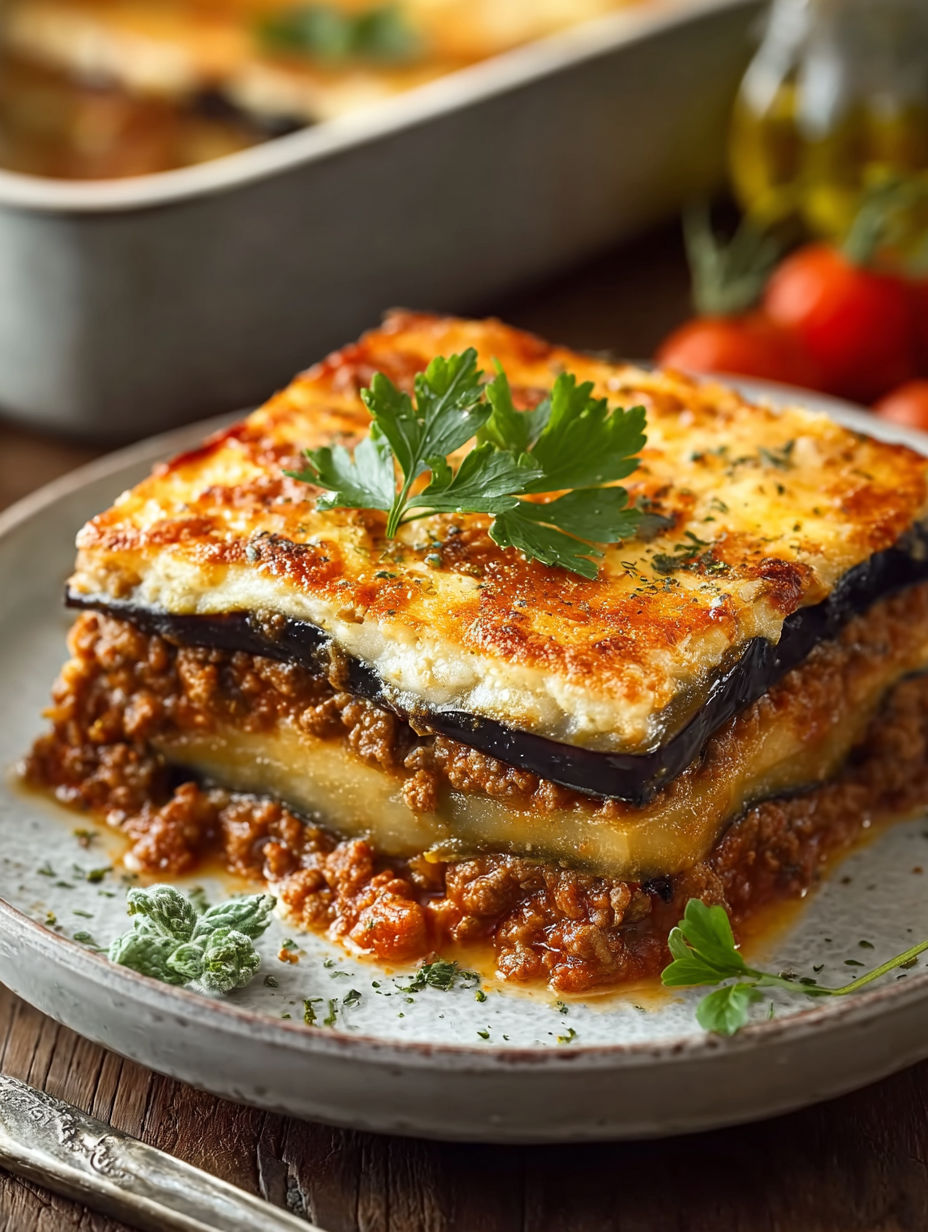 Pin it
Pin it
This hearty Mediterranean Eggplant Moussaka turns simple ingredients into an amazing layered dish that'll make you feel like you're dining seaside in Greece. The velvety béchamel tops sweet roasted eggplant and a boldly flavored meat mixture, making something that's fancy yet totally comforting.
I learned this dish as a kid standing next to my Greek grandma. Watching her confident movements while handling the eggplant made me fall for cooking almost as much as I loved eating the finished moussaka.
- Eggplants go for ones that feel heavy with shiny skin and no mushy parts for better taste
- Ground lamb gives the authentic flavor but you can swap in beef with great results
- Cinnamon this unexpected ingredient creates that special Greek moussaka flavor everyone loves
- Nutmeg brings gentle warmth to the béchamel sauce try grating it fresh if you can
- Oregano get the Greek kind if possible since it packs more punch than Italian versions
- Butter don't skimp here good quality makes your béchamel extra smooth
- Eggs these help your top layer set up nice and custardy
- Tomatoes grab San Marzano ones for their natural sweetness
- Onion and garlic they build the flavor base that makes your meat sauce taste amazing
Delicious Classic Greek Eggplant Moussaka Method
- Get Your Eggplant Ready
- Cut the eggplants into thin slices lengthwise about a quarter-inch thick. Sprinkle salt all over them and put them in a colander in the sink or over a bowl. Let them sit about 30 minutes to get rid of bitter juices and extra water. Then pat them completely dry with paper towels. Brush olive oil on both sides and spread them on baking sheets. Pop them in a 400°F oven for around 20 minutes until they're soft and golden.
- Cook The Meat
- Get a big deep pan hot over medium-high heat. Drop in your lamb or beef without adding oil since the meat makes its own fat. Break it up as it cooks until you don't see any pink anymore which takes about 5 minutes. Let some bits get brown and crispy for extra flavor.
- Add The Flavor Base
- Toss chopped onions in with your cooked meat and let them cook about 4 minutes till they're soft and clear. Then add your chopped garlic and stir for another minute till you can smell it but don't let it burn. These ingredients will give flavor to the whole dish.
- Make Your Meat Sauce
- Add the tomatoes with their juice plus oregano cinnamon salt and pepper. Mix everything well so the spices spread evenly. Turn the heat down to medium-low and let it bubble gently uncovered for 20 minutes stirring now and then. The sauce needs to get thick as it cooks down this makes the flavors stronger for real Greek taste.
- Whip Up The Béchamel
- Melt butter in a pot over medium heat until it bubbles. Sprinkle flour in and keep whisking for 2 minutes until it smells toasty but isn't brown yet. This mix will thicken your sauce perfectly. Slowly pour in warm milk about a half cup at a time whisking hard between each pour to avoid lumps. Cook 5-7 minutes until the sauce gets thick enough to coat a spoon. Take it off the heat and let it cool slightly for 2 minutes.
- Finish Your Sauce
- Beat eggs in a separate bowl. Take some warm sauce and slowly mix it into the eggs while stirring fast. This keeps your eggs from cooking too quickly. Pour this egg mixture back into the main sauce stirring the whole time. Add nutmeg and salt then taste to see if it needs anything else. Your finished sauce should be smooth and rich.
- Put It All Together
- Start by laying roasted eggplant slices on the bottom of a 9×13inch dish slightly overlapping them. Spread all your meat sauce evenly on top and press it down gently to fill gaps. Add another layer of eggplant slices covering everything. Pour your béchamel over the top making sure it reaches all the edges and covers completely.
- Bake Until Beautiful
- Put your dish in a 350°F oven that's already hot and bake for 45-50 minutes until the top turns golden and the edges bubble a little. The béchamel should firm up like custard. After taking it out wait at least 15 minutes before cutting in. This waiting part is super important because it lets all the layers settle and the flavors come together.
You might think cinnamon sounds weird in a savory dish if you've never tried it but trust me it's what makes this special. My grandma always told me good moussaka needs time let each part develop fully before you combine everything. When I cook it now I can almost hear her giving me advice.
All About Salt
Don't skip salting your eggplant. Besides taking away bitterness it really helps the texture so the eggplant won't get soggy during baking. This keeps your layers separate instead of mushy. If you're in a rush you can cut it down to 15 minutes but don't just skip it. After they've been in the oven the eggplant should be soft but still hold together when you pick it up.
 Pin it
Pin it
Wonderful Ways To Serve
Greeks rarely eat moussaka super hot. They usually have it warm or room temperature which lets you taste all the flavors better. Serve it with a simple Greek salad dressed with good olive oil and lemon juice. Add a glass of medium red wine like Agiorgitiko to make it perfect. For a full Greek meal put out some warm pita bread and tzatziki too. The cool yogurt sauce goes great with the rich moussaka.
Keeping Leftovers
This dish actually gets tastier after a day or two as everything melds together. Keep leftovers in the fridge covered for up to 4 days. To reheat put single portions in a 325°F oven for about 15-20 minutes until hot all the way through. Try not to use the microwave as it can make the sauce separate and the eggplant get rubbery. Moussaka freezes really well too. Cut cooled moussaka into portions wrap them up tight and freeze for up to 3 months. Let it thaw in the fridge overnight before warming it up.
 Pin it
Pin it
Frequently Asked Questions
- → Can I make moussaka in advance?
Absolutely! You can assemble it a day ahead and leave it in the fridge for up to 24 hours before you bake. You could also freeze it before baking for three months. If frozen, let it defrost in the fridge overnight before baking. Plan for an extra 10-15 minutes in the oven to ensure a perfect finish when cooking from cold.
- → Why do I salt the eggplant?
Sprinkling salt on eggplant gets rid of its potential bitterness and helps it soak up less oil while it’s cooking. Rinse them well and pat them fully dry before roasting for the best flavor and texture.
- → Can I swap lamb in the recipe?
Lamb is delicious, but ground beef works just as well. For lighter options, try chicken or turkey. Vegetarian? Use lentils, a plant-based meat substitute, or go creative with finely chopped mushrooms and walnuts to match the savory texture.
- → How will I know when the béchamel is ready?
If the sauce clings to the back of a wooden spoon and keeps a straight line when swiped with a finger, it’s ready! Think thick pancake batter. If it thickens too much, whisk in a little warm milk until it’s nice and smooth again.
- → What should I serve with moussaka?
This dish fills you up, but a fresh Greek salad, some crusty bread, or simple greens balance it out beautifully. For a bigger meal, add hummus, warm pita, and creamy tzatziki. And for the wine lovers, go with a crisp white like Sauvignon Blanc for a refreshing pairing.
- → Can I make gluten-free moussaka?
Definitely! Just swap the regular flour in the béchamel for cornstarch, gluten-free flour, or rice flour. The rest of the dish doesn’t have gluten, so it’s an easy tweak if you’ve got dietary restrictions.
